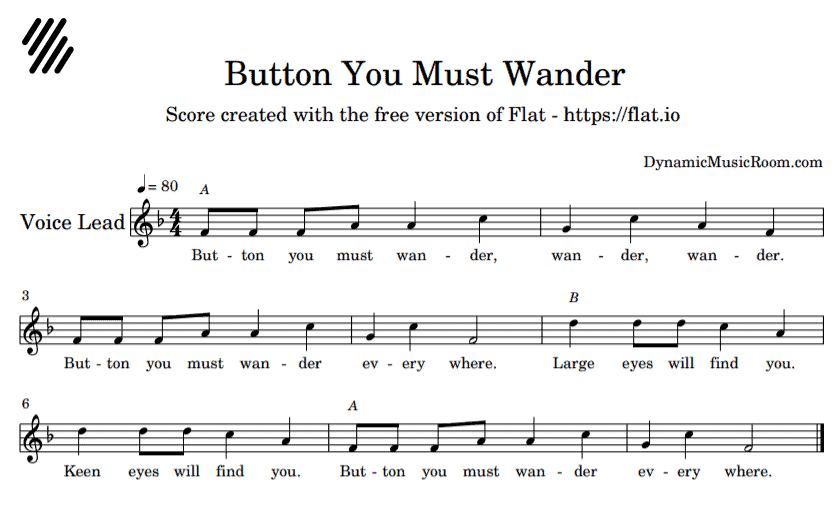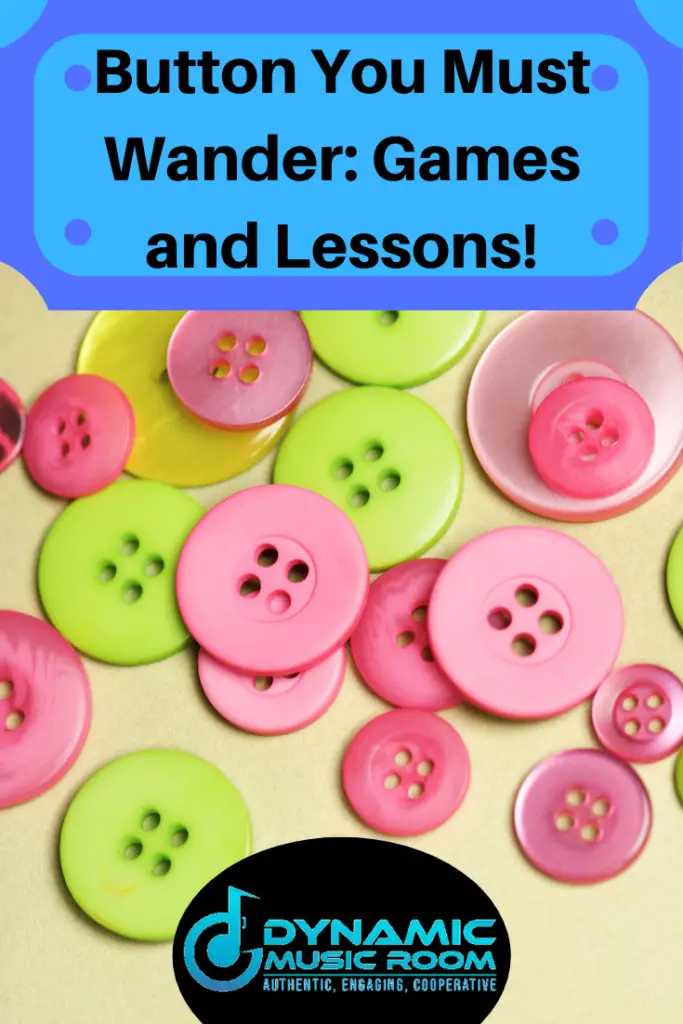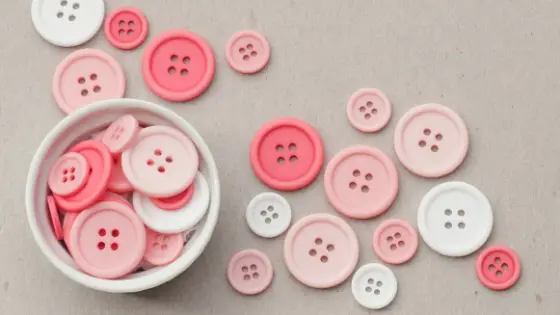Are you looking for a fun song to do with your older students?
Do you want an easy way to teach and reinforce the pentatonic scale?
Older students are tricky to teach, but with the right songs, it’s at least possible.
In my search for engaging songs I came across the great folk song, Button You Must Wander.
Button You Must Wander is a fun folk song and game for any grade level, though older students really get the nuance of the game. It features the full pentatonic scale and uses half notes, paired eighth notes, and quarter notes for rhythms.
Check out the rest of the article for a breakdown of the song, sample lesson ideas, and two games I play with the song.
Table of Contents
Button You Must Wander Song
The song is simple enough even first-graders could sing it, but I save it as a review activity for my older 3rd-5th grade students. This section goes over the important information on the tune.

Lyrics:
Button you must wander
Wander, wander
Button you must wander
Everywhere!
Large eyes will find you
Keen eyes will find you
Button you must wander
Everywhere!
Pitches: do, re, mi, sol, la
Rhythms: half note, paired eighth notes, quarter note
Origin: Unclear, but considered a traditional folk song
Button You Must Wander Games
There are two games I’ve seen played with this song. I’ve done both of them, and they’re both a blast.
Button You Must Wander Finding Game
For the finding game, students don’t need to be sitting in any specific formation. One person is the “finder’, another is the “hider”, and everyone else are the “helpers.”
The hider hides the button or other object while everyone except the finder watches to see where they hide it. After hiding, the hider sits down with the rest of the class.
The finder opens their eyes and searches for the object.
While they search, the class sings the song. As the finder gets closer, the class sings louder and vice versa.
It’s like hot and cold, but loud and soft instead of hot and cold.
Once the finder gets the button object, they become the next hider. The previous hider picks a new finder, and the game repeats.
I usually play this game 7-10 times before I move on to something else. Then, I’ll play this game again the next couple of classes to make sure everyone gets a turn.
Button You Must Wander Tricking Game
To play the tricking version of the game, students should be seated in a complete and connected circle. You need one “giver” and one “guesser”.
Note: This version of the game is considered to be more traditionally accurate.
The guesser closes their eyes while the giver hands the button or other object to someone in the class. The guesser rejoined the circle.
Now, the class begins to sing the song while tricking the guesser. The students are trying to look like they’re passing the button even if they don’t have it.
The guesser has until the end of the song to look at hands and see if they can determine where the button ended up.
Whether they get it right, there is no prize. The guesser becomes the giver, and the one who ended up with the button becomes the guesser.
As with the last version, I usually only play 7-10 times in a single lesson before moving on. Then, I’ll bring the game back in other classes to make sure everyone gets a turn.
To play the game for everyone takes a while, and you risk bored (read: misbehaving) kids.

Button You Must Wander Lesson Plan Ideas
There are a ton of lessons possible from the simple, little song, but here are two of my favorites I like to do with this song.
The concepts for Button You Must Wander fit second/third grade well, but, as I said before, I usually save it to use in reviewing these ideas with my fourth and fifth graders.
Rhythm Lesson Plan Example
Grade: 2-3
Concept: Half note
Behavioral Objectives:
- Students will be able to place the measures of the song in the correct order and perform with rhythm syllables with 80% accuracy.
- Students will be able to arrange the measures of Button to create a new rhythm and perform with syllables on rhythm instruments with 80% accuracy.
Materials Needed: Cut up phrases of Button You Must Wander (enough for groups of three), non-pitched percussion of your choice (one of the things every music teacher needs).
Assessment: The teacher checks the groups throughout the lesson for behavior and rhythmic accuracy. At the end, each group will perform either for the teacher or for the whole class.
The teacher will watch for accuracy of quarter and eighth notes, but specifically watch for the “stretching” over two beats of the half note.
Procedure:
Setup: Students in small groups of 3 spread throughout the room.
- All students echo 3-5 rhythms after the teacher. Rhythms include half notes.
- Teacher explains the first phase of the activity.
- All right, I was printing out copies of the song, Button You Must Wander, when I accidentally chopped them up way smaller than I was supposed to.
- I need you to look at the rhythms in your group and put them back in the right order.
- Make sure you check your work by performing the rhythms with rhythm syllables.
- If you think you have it right, raise your hand, and I’ll come check it quickly for you.
- Students figure out the rhythms while the teacher circulates and assesses.
- Once all have gotten it, give directions for the second phase.
- Wow! You figure it out, but I was impressed with how well your groups worked together and how you all checked your answer and reflected on it. That’s a great life skill.
- Now, let’s try something crazy! Working together, mix up the measures to create a brand new rhythm.
- Then, say the rhythm syllables to see if it’s how you want it. Raise your hand to get it checked with me.
- After it’s been checked, you may get (instrument of your choice) and perform it for the class.
- Students create their own rhythms in groups and follow the directions.
- The teacher either checks groups individually or has them share for the whole class. The teacher offers specific feedback on their performance.
Part-Work Lesson Plan Example
Grade: 3-5
Concept: Part-singing with melodic ostinato
Behavioral Objective:
- Students will be able to sing the melody while a melodic ostinato is performed
- Students will be able to perform melodic ostinato in time with the melody
Materials Needed: No specific materials are needed, though you may find it helpful to write the patterns on the board.
- Do mi sol sol (all quarter notes)
- Do do re mi re do (quart, 2 eighths, 2 eighths, quart)
Assessment:
The teacher will circulate around the room and listen for students who are struggling to offer specific help.
Procedure:
This works best to start in one big circle.
- Ask students to sing the Button You Must Wander song.
- This time, the teacher sings along with the first ostinato pattern (with hand signs!).
- Offer feedback.
- Students sing the song again while the teacher sings the second pattern.
- Teacher teaches the first pattern. The whole class sings and signs the pattern while the teacher sings the song.
- Repeat with the second pattern.
- Split the class into groups. It may be helpful to have these groups reform into two smaller circles.
- One circle sings the song while the other does pattern 1. Switch jobs.
- Repeat the last step with pattern 2.
- Split the class into three circles: one for the song, one for pattern 1, and one for pattern 2.
- Sing and rotate the parts through the circles.
- This may be easily extended on to Orff instruments.
Conclusion
Now you know a lot more about the Button You Must Wander song. These two great games are fun to play, and I hope the lesson ideas help you see how this song could be useful for teaching musical ideas in your classroom.
Make your lessons easier (and admin-friendly) with MyLessonPlanner. I’m an affiliate for them, but I’ve used the program for years with success.

